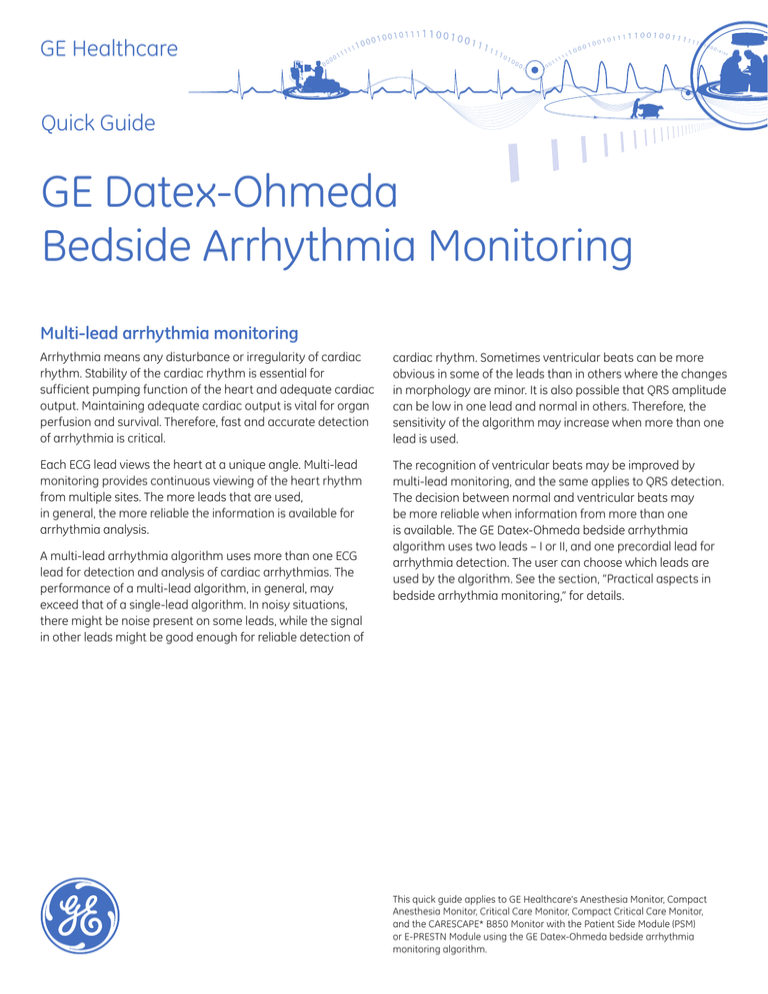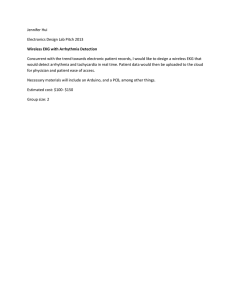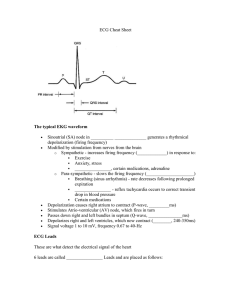
GE Healthcare
Quick Guide
GE Datex-Ohmeda
Bedside Arrhythmia Monitoring
Multi-lead arrhythmia monitoring
Arrhythmia means any disturbance or irregularity of cardiac
rhythm. Stability of the cardiac rhythm is essential for
sufficient pumping function of the heart and adequate cardiac
output. Maintaining adequate cardiac output is vital for organ
perfusion and survival. Therefore, fast and accurate detection
of arrhythmia is critical.
cardiac rhythm. Sometimes ventricular beats can be more
obvious in some of the leads than in others where the changes
in morphology are minor. It is also possible that QRS amplitude
can be low in one lead and normal in others. Therefore, the
sensitivity of the algorithm may increase when more than one
lead is used.
Each ECG lead views the heart at a unique angle. Multi-lead
monitoring provides continuous viewing of the heart rhythm
from multiple sites. The more leads that are used,
in general, the more reliable the information is available for
arrhythmia analysis.
The recognition of ventricular beats may be improved by
multi-lead monitoring, and the same applies to QRS detection.
The decision between normal and ventricular beats may
be more reliable when information from more than one
is available. The GE Datex-Ohmeda bedside arrhythmia
algorithm uses two leads – I or II, and one precordial lead for
arrhythmia detection. The user can choose which leads are
used by the algorithm. See the section, “Practical aspects in
bedside arrhythmia monitoring,” for details.
A multi-lead arrhythmia algorithm uses more than one ECG
lead for detection and analysis of cardiac arrhythmias. The
performance of a multi-lead algorithm, in general, may
exceed that of a single-lead algorithm. In noisy situations,
there might be noise present on some leads, while the signal
in other leads might be good enough for reliable detection of
This quick guide applies to GE Healthcare’s Anesthesia Monitor, Compact
Anesthesia Monitor, Critical Care Monitor, Compact Critical Care Monitor,
and the CARESCAPE* B850 Monitor with the Patient Side Module (PSM)
or E-PRESTN Module using the GE Datex-Ohmeda bedside arrhythmia
monitoring algorithm.
How are arrhythmias monitored at
the bedside?
The GE Datex-Ohmeda bedside arrhythmia algorithm is
based on template matching. (A template is a group of beats
matching the same morphology.) The algorithm detects QRS
complexes, generates QRS templates and performs beat
labeling. This algorithm is divided into three parts: detector,
classifier and labeling. Parallel to this process there is an
algorithm for detection of ventricular fibrillation. Detection
of ventricular fibrillation is based on waveform analysis. The
detector, classifier and labeling all use two leads: the first lead
is I or II, and the second lead is one precordial lead (V1-V6).
The detector algorithm detects waves in the ECG signal that
could be QRS complexes. Then the algorithm separates true
QRS complexes from T-waves and artifacts.
The classifier algorithm forms a template for a normal QRS
complex, which is created during the learning phase. This QRS
complex is later updated upon recognition of a new normal
QRS complex. If the QRS complex is not considered normal, it
is further analyzed with the labeling algorithm.
The labeling algorithm further analyzes the QRS complex and
labels the beat as either ventricular, paced or supraventicular.
This analysis is based on morphological and rhythmical
differences between the detected QRS and the normal
template. However, if there are no significant differences the
labeling algorithm labels the beat normal.
When using the a 3-lead cable, only one lead is measured at
a time. With a 3-lead cable there is only one lead available
for detector, classifier and labeling algorithms, as well as the
algorithm for detection of ventricular fibrillation. The table on
the next page describes the functionality with 5-lead and 10lead cables.
Detection of ventricular fibrillation is based on waveform
analysis. The main criteria for signaling ventricular fibrillation
is irregular waveform with high enough amplitude and
rate. The algorithm for detecting ventricular fibrillation uses
two leads: the first lead is I or II, and the second lead is one
precordial lead (V1-V6).
Detector
• Detects waves in the ECG signal
• Separates QRS complexes from T-waves and artifacts
5-lead cable:
10-lead cable:
• I or II
• I or II
• V
• One precordial
lead (V1-V6)
Classifier
• Updates the normal template after each true
QRS complex
5-lead cable:
10-lead cable:
• I or II
• I or II
• V
• One precordial
lead (V1-V6)
Labeling
• Analyzes each template and labels it as: normal,
ventricular, supraventricular or paced
5-lead cable:
10-lead cable:
• I or II
• I or II
• V
• One precordial
lead (V1-V6)
Ventricular fibrillation detection
• Absence of QRS complexes
• Irregular waveform with high enough amplitude and rate
5-lead cable:
10-lead cable:
• I or II
• I or II
• V
• One precordial
lead (V1-V6)
Practical aspects in bedside
arrhythmia monitoring
Signal quality
Careful skin preparation is very important for good results
in ECG and especially arrhythmia monitoring. Good skin
preparation helps ensure a good signal. The use of highquality electrodes also helps to improve the signal quality.
A good signal helps ensure accurate arrhythmia detection
and especially helps decrease the number of false alarms.
Relearning
When the morphology of the patient’s ECG changes
considerably (e.g. due to removal of a pacemaker), relearning
should be started manually. This can be done in the ECG menu
by selecting Relearn – Start.
Selecting leads for the arrhythmia analysis
The selection of user leads (ECG1, ECG2 and ECG3) on the
monitor affects the leads used for bedside arrhythmia
analysis. The first lead used for arrhythmia analysis is either
lead I or lead II. The algorithm uses the lead appearing first in
the user leads. The second lead used for arrhythmia analysis
is one of the precordial leads (V1-V6). The algorithm uses the
precordial lead appearing first in the user leads.
Bedside arrhythmia alarms
In GE Datex-Ohmeda monitors there are two arrhythmia
analysis modes: Severe and Extended. The Severe mode is
the default and Extended is an optional choice. The Severe
mode detects asystole, bradycardia, tachycardia, ventricular
fibrillation, rapid ventricular tachycardia and ventricular
tachycardia. The details of arrhythmia alarms criteria and the
two modes are described in the following table.
Bedside arrhythmia alarm definitions
Alarm
Criteria
A Fib
Irregular R-R intervals with absence of P waves
Asystole
Cardiac arrest, no QRS complexes for five seconds
Brady
HR below the HR alarm limit
Freq. PVCs
PVCs per minute above the alarm limit
Freq. SVCs
Number of SVCs during the last minute >10
Idiov. rhythm More than four consecutive PVC’s and rate of
successive beats below 40 bpm
Long R-R
interval
R-R interval is longer than 2.8 seconds
Missing Beat
Actual R-R interval more than 1.8 times the average
R-R interval
Multif. PVCs
Over the last 15 beats two or more premature
ventricular beats with different morphologies
are detected
Rapid VT
Five or more consecutive PVCs and rate of
successive beats over 150 bpm
R on T PVC
Early PVC, beat detected as a PVC, preceded and
followed by a normal beat; current R-R interval is
less than half of the previous R-R interval
SV Tachy
More than four consecutive SVCs and HR above
120 bpm and significantly higher than normal rate.
Note: The length of the episode can be configured
to more than 4 or more than 9
Tachy
HR over the HR alarm limit
V Bigeminy
The following pattern is detected: N, V, N, V, N, V
where N = normal, V = PVC (every other beat is
a PVC)
V Couplet
Two consecutive ventricular beats, preceded and
followed by a normal beat, and rate of successive
beats is over 100 bpm
V Fib
Fibrillatory waveform caused by
ventricular fibrillation
V Run > 3
Three or more consecutive PVCs and rate of
successive beats over 100 bpm
V Tachy
Five or more consecutive PVCs and rate of
successive beats over 100 bpm
V Trigeminy
The following pattern is detected: N, N, V, N, N, V, N,
N, V where N= normal, V= PVC (i.e., every third beat
is a PVC)
Note: The Severe mode detects Asystole, Brady, Tachy, V Fib, Rapid VT
and V Tachy. The Extended mode additionally detects the rest of the
arrhythmias mentioned in the table above. Rapid VT is only available
on software versions L-ICU07, L-ANE07, L-ICU07A, L-ANE07A and
above, and Afib, Freq SVC, Idiov. rhythm, Long R-R and SV Tachy on
software versions L-ICU07A, L-ANE07A and above. A Fib, Freq SVC,
Idiov. rhytm, Long R-R, Rapid VT and SV Tachy are not available for the
CARESCAPE Monitor B850.
Additional resources
For white papers, guides and other instructive materials about
our clinical measurements, technologies and applications,
please visit http://clinicalview.gehealthcare.com/
© 2011 General Electric Company – All rights reserved.
* GE, GE Monogram and CARESCAPE are trademarks of
General Electric Company.
GE Healthcare reserves the right to make changes in
specifications and features shown herein, or discontinue
the product described at any time without notice or
obligation. Contact your GE Healthcare representative
for the most current information.
GE Healthcare Finland Oy, a General Electric company,
doing business as GE Healthcare.
GE Healthcare, a division of General Electric Company.
CAUTION: U.S. Federal law restricts this device to sale by
or on the order of a licensed medical practitioner.
Consult the monitor User’s Guide for detailed
instructions.
About GE Healthcare:
GE Healthcare provides transformational medical technologies and services that
are shaping a new age of patient care. Our broad expertise in medical imaging and
information technologies, medical diagnostics, patient monitoring systems, drug
discovery, biopharmaceutical manufacturing technologies, performance improvement
and performance solutions services help our customers to deliver better care to more
people around the world at a lower cost. In addition, we partner with healthcare leaders,
striving to leverage the global policy change necessary to implement a successful shift
to sustainable healthcare systems.
Our “healthymagination” vision for the future invites the world to join us on our
journey as we continuously develop innovations focused on reducing costs, increasing
access and improving quality around the world. Headquartered in the United Kingdom,
GE Healthcare is a unit of General Electric Company (NYSE: GE). Worldwide, GE Healthcare
employees are committed to serving healthcare professionals and their patients in more
than 100 countries. For more information about GE Healthcare, visit our website at
www.gehealthcare.com.
GE Healthcare
8200 West Tower Avenue
Milwaukee, WI 53223
U.S.A.
www.gehealthcare.com
GE Healthcare Finland Oy
Kuortaneenkatu 2
00510 Helsinki
Finland
GE Healthcare
3/F Building # 1,
GE Technology Park
1 Hua Tuo Road
Shanghai 201203
China
DOC0506507 rev2 8/11





